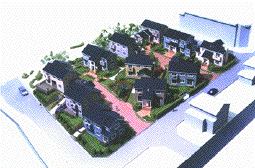
IMPORTED HOUSING:
Housing Corporation Constructs First Imported House
SEPTEMBER 13, 1996

Detached Houses Using More Than 70% Foreign Materials
As imported housing becomes increasingly popular in Japan, the Housing and Urban Development Corporation has begun the construction of its first houses, that use imported materials in abundance. The 11 ready-made, two-story houses under construction using two-by-fours are located in the city of Tsukuba in Ibaragi Prefecture, which is within commuting distance from the center of Tokyo; they are scheduled for completion in December.
The materials that are being used come from North America and other foreign countries. In addition to the timber for the house structures, imported materials are used for various aspects of the interior, including the sashes, doors, floors, and washstands. Overall, imported materials account for 74% of material costs. The price of the houses apparently will be about 6% cheaper than if only domestic materials were used.
The land area and building area per house are 197-234 square meters and 116-130 square meters, respectively; the houses have four or five rooms plus a living room and dining room/kitchen. Since North American measurement standards are used, the rooms are a little larger than is usual for domestic housing. The houses will be priced around 50 million yen (450,000 U.S. dollars at the rate of 110 yen to the dollar). Buyers will be solicited at the end of the year, and occupants are scheduled to move in next spring.
Imported Materials for Apartment Complexes, Too
The Government, which aims to lower housing prices, expand domestic demand, and increase imports, is supporting this expansion of imported housing by, for example, relaxing regulations concerning the two-by-four method. In 1994 the Government formulated an action plan for the gradual reduction of housing construction costs, and the Housing and Urban Development Corporation's building of imported houses is a model project under this plan.
Generally speaking, imported housing refers to housing in which imported materials account for more than 50% of the total materials used. The two-by-four method, by which housing design methods are borrowed from North America or Scandinavia, the main materials standardized from inexpensive foreign timber are imported, and the structures are assembled at construction sites in Japan, accounts for 80% or nearly all of imported housing construction.
Compared with domestic housing, imported houses usually have a more solid structure, with stouter pillars and slightly thicker plywood. They are considered to have excellent earthquake resistance, too. Moreover, since they use heat insulating materials amply on floors, walls, and ceilings and double glazing on windows, their airtightness and heat insulation are also good selling points.
Previously the construction of imported housing was restricted to rather high-class units, so demand was limited. With the continued appreciation of the yen and decline of construction costs in recent years, however, an increasing number of companies have begun introducing more common imported housing suitable for wider diffusion. As a result, the popularity of imported housing is increasing. According to the Ministry of Construction, the number of imported houses constructed in fiscal 1995 reached 4,575 units, up 75% from the previous fiscal year.
When people who already reside in imported houses are asked for their impressions, their replies are full of such praise as "the quality is good, with excellent sound insulation" and "the rooms are spacious, and I like the fact that there are plenty of open spaces."
The construction of imported housing in Japan is expected to increase considerably from now on. Next, the Housing and Urban Development Corporation is thinking of actively using imported materials in the building of apartment complexes.